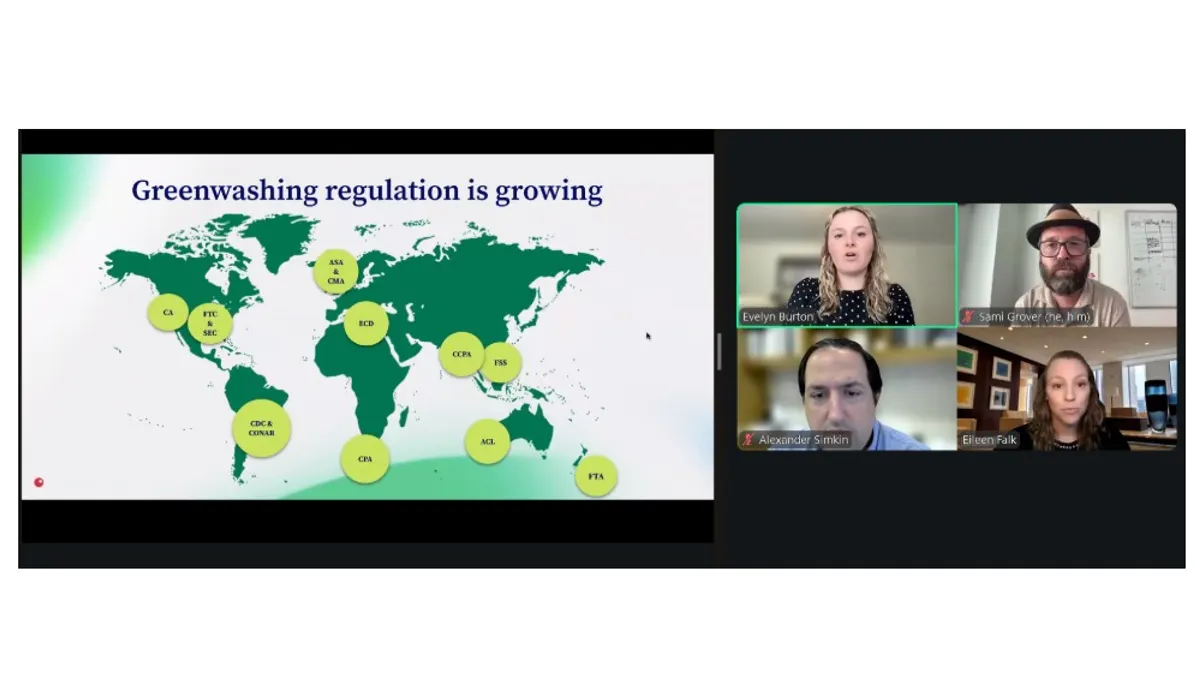It’s becoming even riskier for companies to present misleading environmental or sustainability claims — a practice dubbed “greenwashing” — due to wider user of technology to weed out bad actors and growing legal judgments, speakers discussed during a recent webinar led by sustainability strategy and communications consultancy thinkParallax and law firm Ropes & Gray.
“We're regularly seeing settlements and judgments in the millions to tens of millions of dollars,” said Alexander Simkin, partner at Ropes & Gray. “If a problematic statement [were] made to enough people in connection with a sufficiently valuable product or service, there's no reason under the law why the damages couldn't be hundreds of millions of dollars or more.”
Updated Green Guides remain at bay
Some state and international regulators are taking action to keep companies’ sustainability claims in check. But updates appear stagnant for the U.S. federal government’s environmental marketing claim guidelines.
“One example where we're just not seeing forward movement where we expected to is the FTC Green Guides,” said Eileen Falk, associate at Ropes & Gray, which were last updated in 2012.
Falk noted that these guidelines help companies avoid making environmental claims that mislead consumers. In 2022, the Federal Trade Commission accepted public comments on updates, and those revisions were expected in 2024. That process paused with the change in administration.
“They would have to re-review those,” she said. “And now we haven’t heard anything from the administration in months on whether the Green Guides are going to be updated. It doesn't seem like that's a priority right now.”
AI will change how greenwashing is identified
Today, there are more ways for bad actors to be called out. “You don’t have to have a pissed-off customer to get in trouble,” said Sami Grover, communications director at thinkParallax.
Simkin noted increased pressure from activist groups, nonprofits and other campaigners that is driving greater scrutiny from both government regulators and private plaintiffs.
In one packaging-related example last year, Keurig Dr Pepper agreed to pay a $1.5 million civil penalty to settle charges levied by the U.S. Securities and Exchange Commission over inaccurate statements about the recyclability of its K-Cup single-use beverage pods.
Notably, advances in technology and artificial intelligence “are allowing regulators to monitor green claims online with much greater breadth than they had been previously,” he said. Plaintiffs are often profit-motivated, “and the fact that they've gotten some meaningful judgments and settlements, I think, further incentivizes increased litigation in this area.”
Falk agreed that regulators are being more proactive in scanning the web for violations. “It's increasing the speed at which violations are identified,” and also finding lower-profile violations “that might have gone under the radar before,” she said.
Sustainability messaging calls for progress over perfection
Companies can be proactive about coordinating between departments, such as legal and marketing, and keeping records of the sustainability claims they make and the “why” behind them to ensure they’re substantiated, Falk said.
“Obviously, [it might be] a bit of a hassle to set some of these policies, procedures and trainings,” said Falk, but less of a hassle than facing an investigation and “back-end nightmares” like figuring out what the company meant by a claim or who approved it.
Companies don’t need to present an image of perfection when telling their sustainability story, said Grover.
“I think the majority of people who are paying attention to this aren't expecting perfection, and they don't want perfection, but what they do want to see is you making a concerted, real ambitious effort to tackle the challenges that you face,” Grover said. “And the good news is: That's usually a better story, anyway.”










